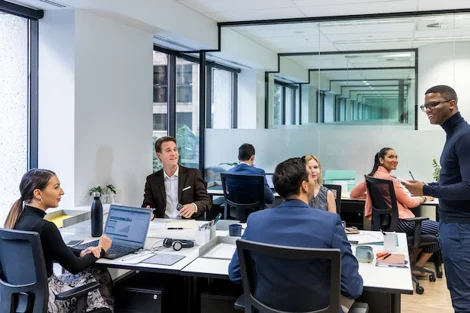
The Rise of Flexible Office Space in Australia
SHARE

Can you remember the last time you hailed a taxi instead of requesting an Uber? How about the last time you took a trip – did you exclusively look at hotels or did you look at accommodation on Airbnb as well? When was the last time you ordered your dinner directly through a restaurant, rather than a third-party app?
The Tech Disruptions
Disruptive innovations and the industries they impact are nothing new to Australians. Technologically savvy and known as the innovation test subjects for the Western world, Aussies are used to being on the forefront of testing new ideas from global industry leaders. Did you know the first McCafe was opened in 1993 in Melbourne? How about the fact that the global debuts of Coca-Cola’s ‘one brand’ visual redesign in 2016 and the popular ‘Share a Coke’ campaign in 2011 first appeared in Australia?
Many of us have embraced these new ways of living with open arms - and for good reasons. An Uber is more reliable than a taxi, and it comes with time estimates and the ease of linked payment methods. Menulog, UberEats and Deliveroo all include discounts as well as real-time tracking. Airbnb's are usually far cheaper, more centrally located and feature an unbeatable amount of privacy compared to traditional accommodation. We like disruptive industries because they offer a flexible solution that can be tailor-made to fit us – and a lot of the time, they are just plain easier (They’re also a lot lighter on the wallet!).
So, why would the traditional Australian office space industry be any different?
Coworking as a Disrupter
With the world still in the grips of the COVID-19 pandemic, working from home (or #wfh as it’s trending on social media) has become the new norm across much of Australia’s workforce that is able to do so remotely. Initially introduced as a temporary measure, this shift in the traditional working day has led many to question whether this new way of working will remain even after the end of the COVD-19 pandemic. Has COVID-19 helped us re-imagine the traditional office space in Australia?
The quick answer is: the time of traditional office spaces in Australia was already coming to an end.
The growing demand for coworking spaces was firmly in full swing across global markets long before the disruption of COVID-19, and the Australian office space industry had already begun to shift. Flexible office space and coworking spaces currently account for 15% of London and Amsterdam’s commercial real estate market, and pre-COVID-19 - it was predicted that coworking spaces will grow by 42% globally in 2020.
Australia is quickly following suit, with coworking spaces currently on a trajectory set to account for up to 30% of all commercial property in Australia by 2030. While these results were produced prior to the COVID-19 pandemic, the trajectories may only falter slightly, as flexibility and financial cautiousness will definitely come to define or at least deeply impact the post-COVID-19 commercial rental market.
Not only is coworking set to become the ‘new norm’ of Australian work culture, but it is an inevitable global market shift.
While the early models of coworking have always been popular among freelancers, contractors, and start-ups; predictions show the biggest benefactors to this new way of working could be Australian small business owners. The growing demand has highlighted the benefits of coworking spaces that can transcend into other industries.
With 98% of Australia’s businesses in 2019 classified as a small business with 20 or fewer employees, rigid commercial leases, as well as the unexpected costs and hassles of office maintenance always posed formidable risks. Now, compounded with financial uncertainty and the long-term economic damage of COVID-19, small businesses need to reconsider their workspace options (and the prices they pay for them) more than ever.
As the spread of COVID-19 in Australia begins to slow, the public conversation around relaxing social distancing measures is beginning to emerge with speculation on what industry or part of public life will be relaxed.
Coworking in Australia
Understandably, the reopening of workspaces is one of the main considerations. As most of Australia’s office workers have adjusted to the lifestyle of remote working (with mixed feelings), financially savvy businesses should be exploring the options of coworking spaces as a way to resurrect their businesses with a smaller amount of financial risk. The choice of flexible office space and coworking space over a traditional commercial lease just simply makes good economic sense for Australian small businesses. Coworking offices present a relevant hybrid model for workspaces with the flexibility to grow or shrink your team, employ flexible working hours, create bespoke offices and negotiate leasing terms more freely.
A recent survey uncovered the importance of communal spaces in a workspace that instigates face-to-face interactions and collaborations. 75% of respondents felt it was important for their workplace to intermingle with the surrounding community – be it other businesses on the street or other workers in their building. The long-term effects of remote working have proven to be counterproductive for larger scale businesses also. This is why IBM re-established their office space in 2017, pulling many employees back into the physical space, despite publishing a paper in 2014 defending the large scale remote working model.
Networking is essential in the world of small business and entrepreneurship; and as such, many coworking spaces host a variety of community events to help share business expertise and connections throughout their community.
What are the benefits of Coworking?
Now, in the current climate of financial uncertainty, the benefits of coworking space solutions are more relevant than ever. Why take the risk on a 3-5 years lease in an out of the way location, when there is the option for something more affordable that already includes furniture, IT support and meeting room facilities is readily available on a month to month basis?
You may also be asking, why don’t Australian’s just quit the idea of an office altogether? In short, the reality is an entire company’s workforce working from home is not a sustainable business plan or effective model for increasing employee satisfaction. What is sustainable – and heavily predicted to happen – is the shift to more flexible working options and hours.
Recent studies show that the effects of long-term working from home can have significant negative effects on employees with regards to social and professional isolation. The importance of collaboration, networking and face-to-face impressions in our professional careers is not likely to decline anytime soon. Instead, what will most likely result in a decrease in the number of days spent in the office per worker – not a decline in the offices themselves.
Despite how much you have enjoyed this period of working from home during the COVID-19 pandemic, having a designated physical office space has more positive impacts on your work-life balance in the long run. Studies have shown that by turning up to an office space your working hours are much less likely to be extended than if you were to continue working from home. Consistently working alongside others in a designated office space also results in less resentment between colleagues and produces a more cohesive team and work ethic.
What is the future of Coworking?
One thing is clear: The Australian workforce needs more than just a ‘one-size-fits-all’ model. The most comprehensive option is to consider the importance of flexibility and ensure financial security. This was predicted early on with a surge in the popularity of virtual memberships and coworking spaces at the initial beginnings of social distancing in Australia.
When lockdown measures were starting to become enforced, many businesses still realised the need for a physical location, meeting point and meeting amenities - such as a virtual office. The end to lockdown measures will see a rush to return to the normalcy of work, and a push from our government to kick off the economy once again. Many businesses have adopted business continuity plans, with after-COVD-19 strategies already being considered and put into place.
Opting for flexible office spaces and working hours is an obvious answer when considering a post-COVID-19 business strategy. Coworking spaces will inevitably rebound and explode at the end of the pandemic, so why not get on the front foot and ensure the future of your business by inquiring about a coworking space with Christie Spaces today.
Related articles


The Cost Benefits of Having a Flexible Office Space


